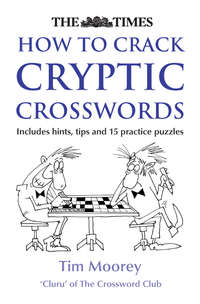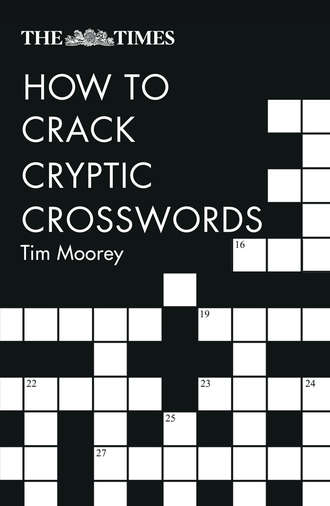
Полная версия
The Times How to Crack Cryptic Crosswords
What can be difficult, however, is where the same common word in the English language serves as an indicator for several clue types. The words in and about are the most problematic examples of this and you will find more about these and equally troublesome words in Chapter 10.
Chapters 1–3: summary
Here are two charts offering in summary form the basic points of Chapters 1, 2 and 3. First, a summary of clue types, typical indicators and what the solver must do:
CLUE TYPE TYPICAL INDICATORS WHAT TO DO Types 1–8 Indicators included in clue ANAGRAM New, mixed, changing, drunk, in error Change letters to another word SANDWICH (OUTSIDE) Holding, keeps, contains Put some letters outside others SANDWICH (INSIDE) In, breaks, cutting, interrupts Put some letters inside others HOMOPHONE Mentioned, we hear Find a word sounding like another HIDDEN Some, partly, within Find a word within other words REVERSAL (ACROSS CLUE) Back, over, returns Turn letters backwards REVERSAL (DOWN CLUE) Up, over, served up Turn letters upwards TAKEAWAY Less, without, drop, cast Deduct some letter(s) from a word LETTER SWITCH For, replacing, moving Exchange or move letters ALL-IN-ONE Various, depending on wordplay Use wordplay to find solution which is then defined by the wordplay Types 9–12 Indicators (usually) not included in clue ADDITIVE Usually none given Add letter(s) to other letter(s) DOUBLE DEFINITION None given Find solution from two or more distinct definitions, side by side CRYPTIC DEFINITION None given Find solution from puns, hints, ambiguities; ignore surface reading NOVELTY None given Think laterallySecond, here’s how each clue type can be used for the same solution word time, (defined as the US magazine in 10 clues). Indicators are underlined.
CLUE TYPE CLUES WHAT TO DO Types 1–8 ANAGRAM New item in magazine Change letters of ITEM SANDWICH (OUTSIDE) Match bringing in millions for magazine Put MATCH = TIE outside MILLIONS = M SANDWICH (INSIDE) Millions put into match magazine Put MILLIONS = M inside MATCH = TIE HOMOPHONE Herb mentioned in magazine Find a word for a HERB sounding like TIME (THYME) HIDDEN Some sentimental magazine Find a word within SENTIMENTAL REVERSAL (ACROSS CLUE) Magazine issue backed Reverse ISSUE = EMIT REVERSAL (DOWN CLUE) Magazine issue taken up Reverse ISSUE = EMIT TAKEAWAY Nameless chaps behind note in magazine Remove NAME = N from MEN; add NOTE = TI LETTER SWITCH Magazine volume, one for nothing Replace NOTHING = O in VOLUME = TOME with I ALL-IN-ONE Male, interned in Windsor is doing this? Put MALE = M inside WINDSOR = TIE Types 9-12 ADDITIVE Note yours truly in magazine Add NOTE = TI to YOURS TRULY = ME DOUBLE DEFINITION Bird magazine Two ways of expressing time, BIRD is time in prison CRYPTIC DEFINITION Wilde did it in a sentence Think of Oscar W in prison NOVELTY Spell centimetre: this is in middle – in middle! Find TIME centrally inside CENTREWHY ARE SOME CLUES MORE DIFFICULT THAN OTHERS?
Levels of cryptic difficulty are shown by these sandwich clues, all using the same definition don’t worry and all giving the same answer but with differing wordplay:
Ned catches vermin, don’t worry (5,4): The letters to be manipulated are in the clue ie Ned outside vermin
Edward catches vermin, don’t worry (5,4): A small change from Edward to Ned is required
Boy catches mice, don’t worry (5,4): Two changes are needed as mice has to become vermin
I hope you got never mind as the answer in each case. If you didn’t, never mind, as the point remains that while clue structures are the same, synonyms have to be found before the sandwich can be made and it is this that makes solving more difficult. Of course, unusual words as answers and obscure references are other causes of difficulty.
4: Tips for Solving Clues
“This isn’t biography. It’s the only thing the English are good at… crossword puzzles.”
Alan Bennett, Kafka’s Dick
Having considered clue types and various points associated with each, we will now consider some tips on how you might go about solving them.
Seasoned solvers have many ways of uncovering a clue’s solution. The ones following are in no particular recommended order of importance, except that the first two are often quoted as ways to get started.
1. Find the definition
As you know by now, the definition part of nearly all clues is either at the beginning or end of a clue. Identifying it quickly, and assessing the definition in conjunction with word-length shown, allows the possibility of a good initial guess which can then be checked against wordplay before entry.
2. Find an indicator and/or clue type
Not all clues have indicators, as we have seen, but where they do, try to use them to identify the clue type. For example, you may spot a familiar anagram indicator such as mixed or battered and thence compare the letters in the anagram fodder with the word-length of the solution given. If they correspond, there is a good chance that you have identified the wordplay element of the clue and can develop that into a possible solution.
3. Ignore the scenario
Setters do their best to produce clues which paint a smooth, realistic picture, referred to as the surface meaning or just surface. Try to ignore it however and look at the individual components in front of you. Take the clue overleaf, seemingly about a party:
ADDITIVE CLUE: Last ones in get no sherry trifle (3)
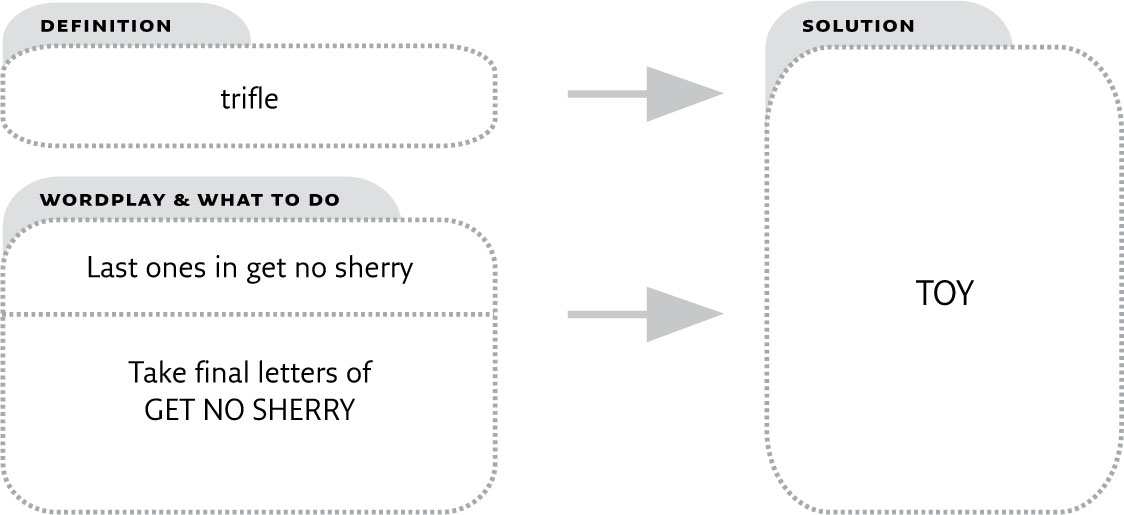
You can be pretty sure that recalling memories of children’s parties will not be productive. It’s just a clever deception by the use of ones for letters and a letter selection indicator, last (see Chapter 3, here), leading to trifle = toy.
TOP TIP – SURFACE MEANING
The ability to look beyond surface meaning is what newbies find the hardest part of cracking a cryptic clue. My advice can only be to keep trying.
4. Exploit word-lengths
Use friendly word-lengths such as 4,2,3,4 with the central two being perhaps something like in the or of the; and 4,4,1,4 nearly always embracing the letter A, from which something like once upon a time may be the guessable answer.
5. Study every word
Consider each word carefully, separately and together. Disregard phrases which go naturally together such as, say, silver wedding, and split them into their parts. It could be that the definition is silver on its own and wedding is part of the wordplay.
In doing this, think of all the meanings of a word rather than the one that comes first into your head.
For example, forget drink in its marine sense in the next clue and switch to alcohol. The indicator some makes it a hidden clue.
HIDDEN CLUE: Some termed ocean the drink (5)
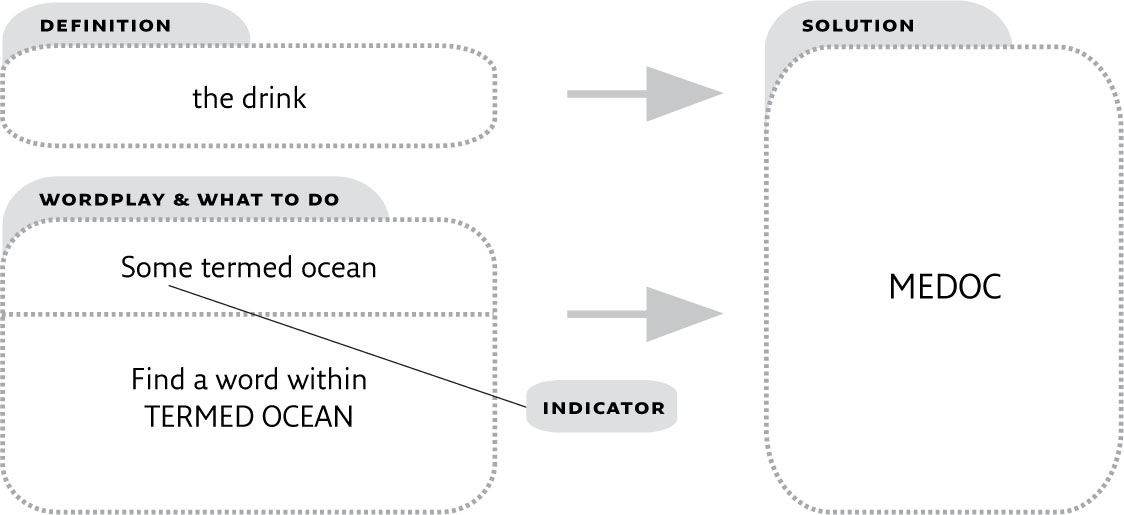
Here is another misleading image in the second example below, which has nothing to do with music:
HOMOPHONE CLUE: Cor Anglais’s third piece heard (3)
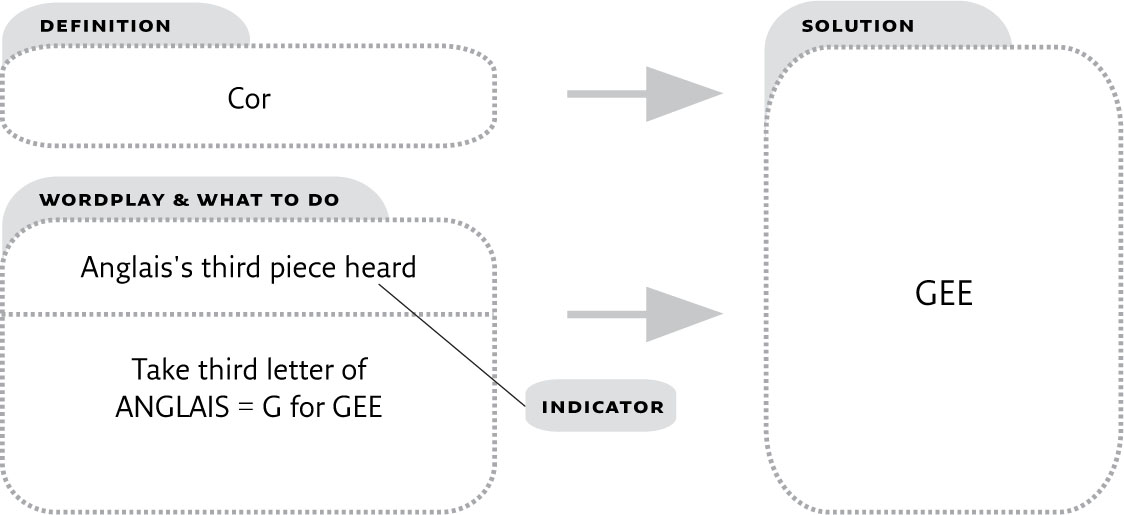
Last, an instance, overleaf, of how separating the sentence into even its smallest parts is sometimes needed. This clue is a further demonstration of a letter selection indicator, empty for lane leaving the two letters le, and of a deceptive definition.
ADDITIVE CLUE: Perhaps a lorry needing empty lane (7)

6. Write bars in grid
Given word-lengths that indicate more than one complete word (e.g. 3-7, or 3,7), some solvers automatically write the word divisions as bar-lines into the grid and find that helps. The bars can be either vertical or horizontal depending on whether they are split words or hyphenated words. This little trick can be especially useful when the word to be found is in two parts and the first letter, say, of the second of the parts is given by an intersecting solution.
7. Ignore punctuation
In a nutshell, only exclamation marks and question marks at the end of a clue are meaningful; other punctuation should usually be ignored. For example, the anagram fodder can include letters or words with a comma or other punctuation in between, as in this tricky clue:
ALL-IN-ONE ANAGRAM CLUE: Sort of roll, A–E etc? (9)
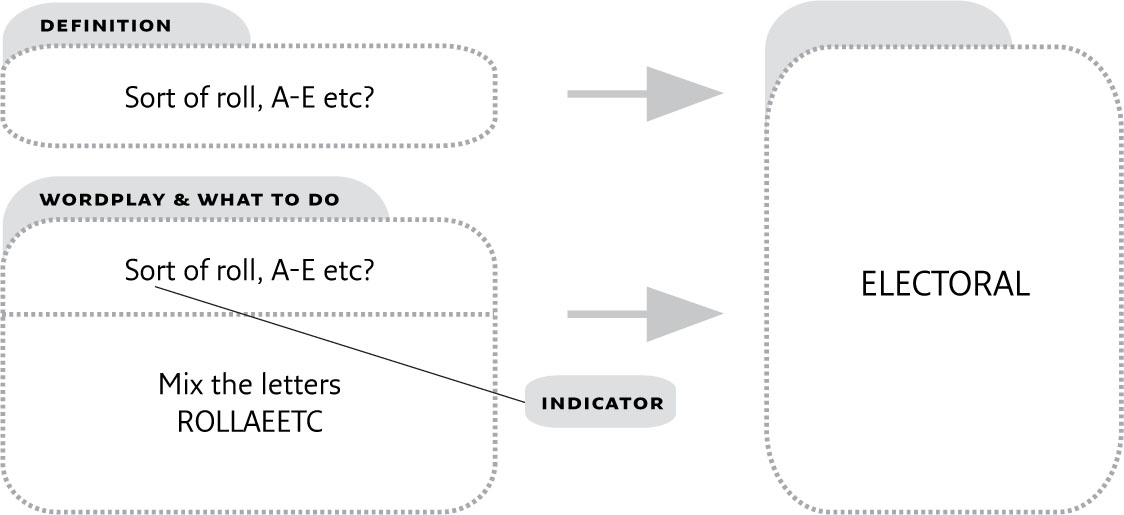
Another example of this is seen in the clue that follows:
HIDDEN CLUE: Rabbit produced from magic hat? Terrific (7)
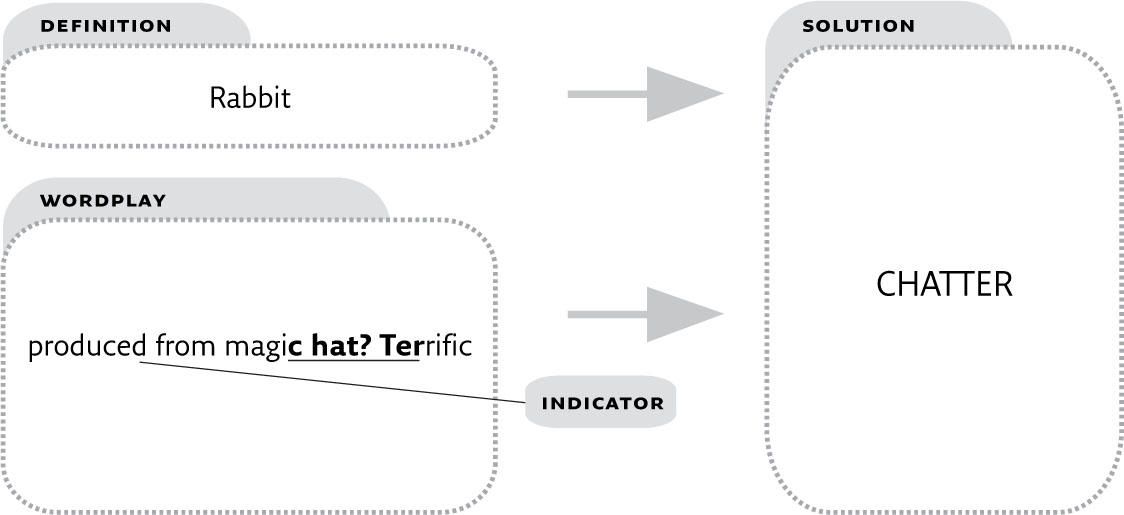
The question mark and capital T are both to be ignored. There is more on misleading punctuation in Chapter 9
Конец ознакомительного фрагмента.
Текст предоставлен ООО «ЛитРес».
Прочитайте эту книгу целиком, купив полную легальную версию на ЛитРес.
Безопасно оплатить книгу можно банковской картой Visa, MasterCard, Maestro, со счета мобильного телефона, с платежного терминала, в салоне МТС или Связной, через PayPal, WebMoney, Яндекс.Деньги, QIWI Кошелек, бонусными картами или другим удобным Вам способом.


